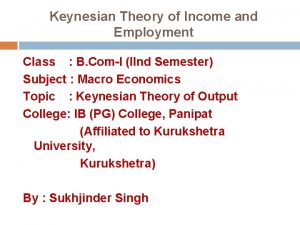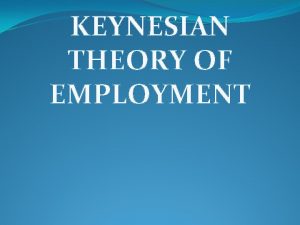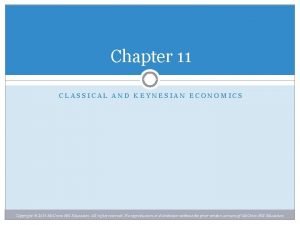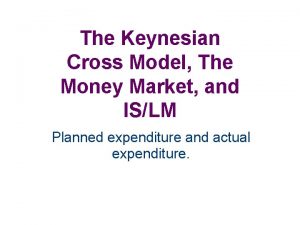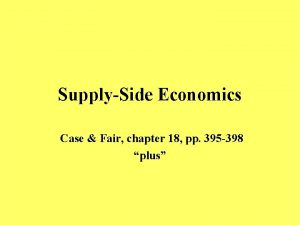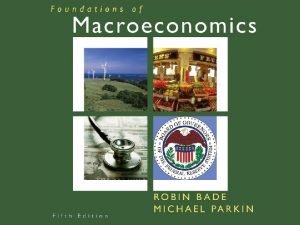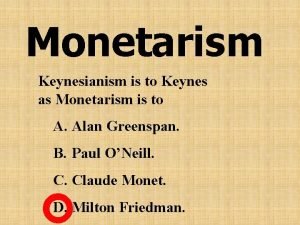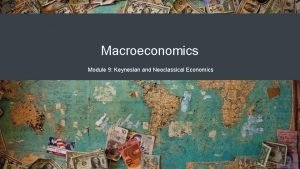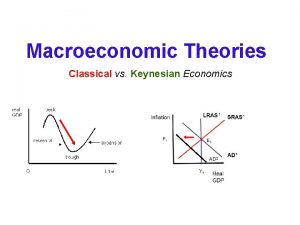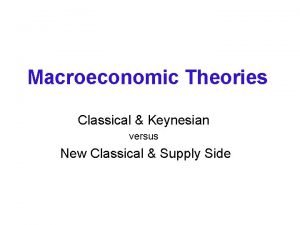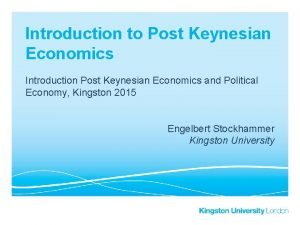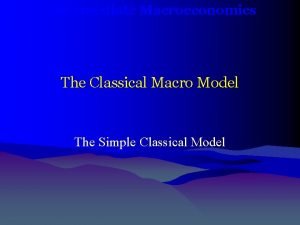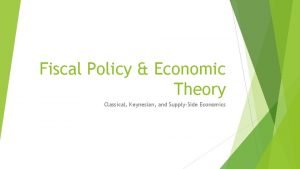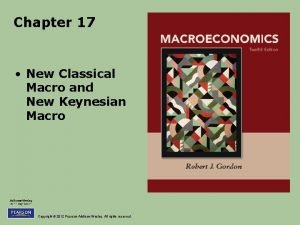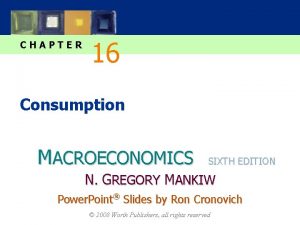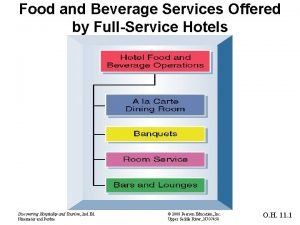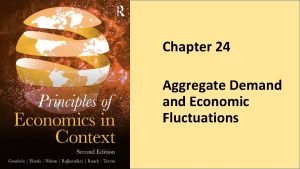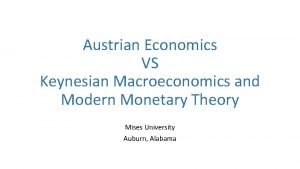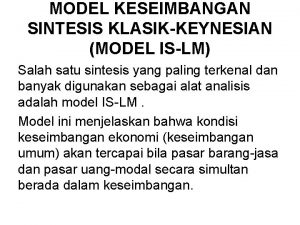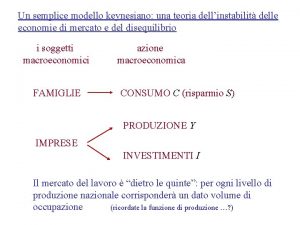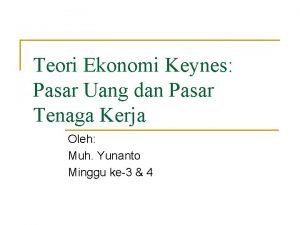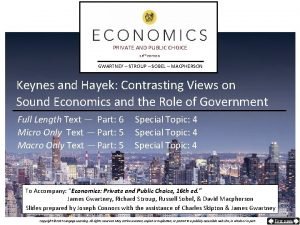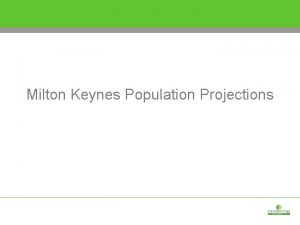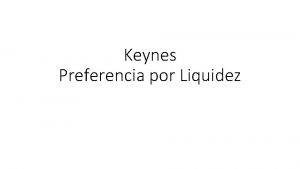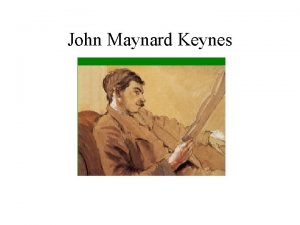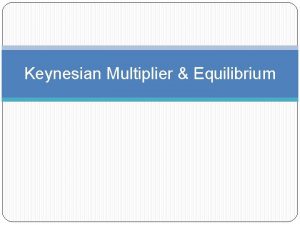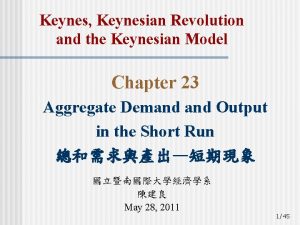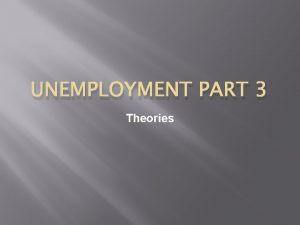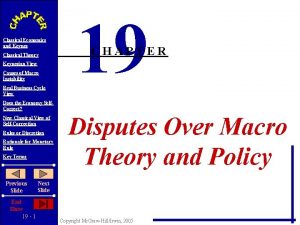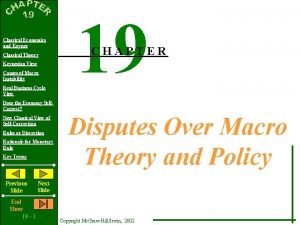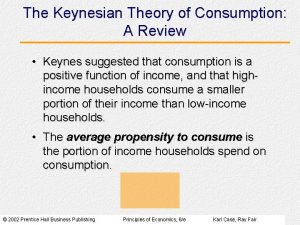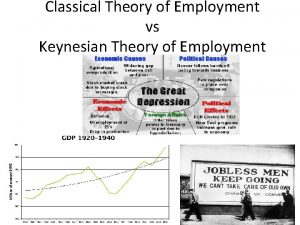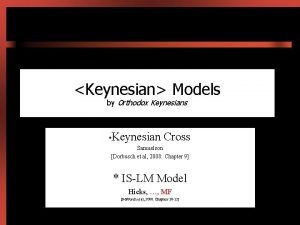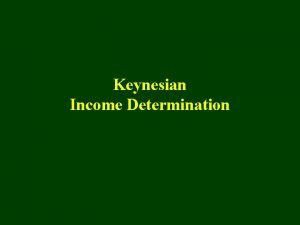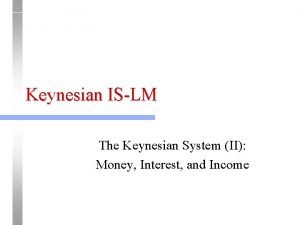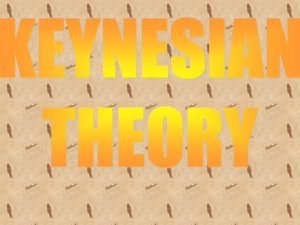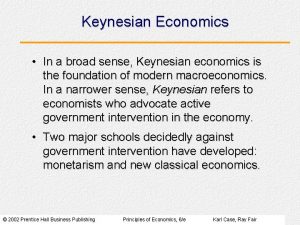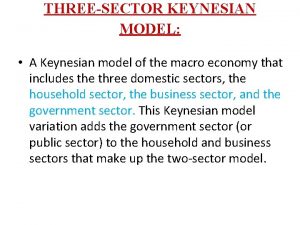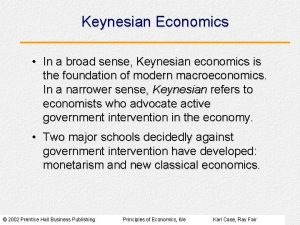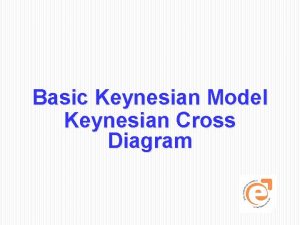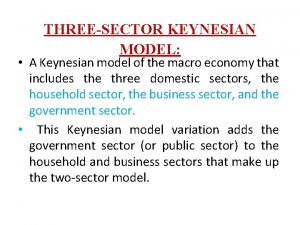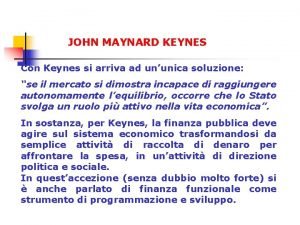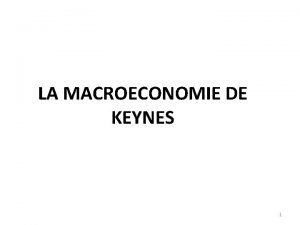KEYNESIAN THEORY OF EMPLOYMENT Keynes offered this theory




































- Slides: 36

KEYNESIAN THEORY OF EMPLOYMENT

Keynes offered this theory in 1936. Keynes explained in this theory that employment depends upon the income. If the standard of national income is higher then rate of employment will also be higher. On the other hand if the level of national income is lower then the level of employment will also be lower. The equilibrium level of income and employment will be that where aggregate demand is equal to the aggregate supply.

According to Keynesian, the main reason of unemployment is deficiency of aggregate demand. Aggregate demand can be increased by increasing investment, as consumption remains constant in short period. During period of depression the expectation of profit is remote. Thus private sector will not make any investment. Hence to achieve the objective of full employment investment by government will be called.

1. It has been assumed that period taken is short run. 2. There is no change in the amount of capital. 3. There exist perfect competition in market. 4. There is no foreign trade. 5. There is no government interference. 6. The propensity to consume is stable. 7. There should be no change in the methods of production. 8. There should be no change in a distribution of wealth. 9. Saving is the function of the income. 10. Labour is the only factor of production. 11. Investment is function of rate of interest.

EXPLANATION Keynes proved this fact that supply can not create its own demand, and there is no tendency of the economy towards full employment. If at any time aggregate demand falls, then unemployment takes places and if aggregate demand increases then inflation takes place. As regards the question of national income and employment determination it is determined by the aggregate supply and aggregate demand. According to Keynesian theory, National Income is the function of level of employment. Y = f (N) Level of employment is a function of effective demand. N = f(ED)’ Effective demand expresses the equality between aggregate demand aggregate supply ED – AD =AS

NATIONAL INCOME EMPLOYMENT EFFECTIVE DEMAND AGGREGATE DEMAND CONSUMPTION PROPENSITY TO CONSUME AGGREGATE SUPPLY INVESTMENT NATIONAL INCOME FACTOR COST MARGINAL EFFICIENCY OF CAPITAL NORMAL PRICE RATE OF INTEREST

AGGREGATE SUPPLY : According to Keynes aggregate supply is equal to national income at market price. In other words national income is equal to the price of goods and services produced in the country. The national income is divided into three parts, consumption saving and taxes. So Aggregate supply = National income = Consumption + Savings or AS = Y = C + S AGGREGATE DEMAND : Aggregate demand is the amount of consumption and amount of investment expenditure at each level of income. There are two components of aggregate demand. 1. Consumption expenditure ( C ). 2. Investment expenditure ( I ). Aggregate demand can be expressed as Y = C + I

Consumption Expenditure : It depends upon the size of national income. If the size of national income is greater then greater amount will be spent on consumption. In other words the marginal propensity to consume is grater then the gap between consumption and income is small and the level of employment will be high. AVERAGE PROPENSITY TO CONSUME The willingness to use a proportion of income (Y) for consumption (C) is known as average propensity to consume (APC): APC=C/Y As income increases, the average propensity to consume decreases. This is indeed observable in the fact that wealthy individuals consume a smaller proportion of their income than to poorer people who may in fact be force to receive money from others

Investment Expenditure : The investment expenditure depends upon the following two factors : 1. Marginal Efficiency of Capital 2. Current Rate of Interest If the marginal efficiency of capital is lower than the rate of interest, the demand for investment will be low. The aggregate demand curve rises upward from left to right. EFFECTIVE DEMAND : According to Keynes the level of income and employment is determined at a point there aggregate demand curve intersect aggregate supply curve.

Employment (in lakhs) Aggregate Demand (in crore) Aggregate Supply (in crore) Trend of employment 0 100 0 Rise 10 360 120 Rise 20 420 240 Rise 30 480 360 Rise 40 540 480 Rise 50 600 Equilibrium 50 640 720 fall Above table indicates that when level of employment is 50 lakhs , then both aggregate demand aggregate supply are equal at Rs. 600 crore. It is an equilibrium situation. The aggregate demand under this situation is called effective demand.

In figure, employment is shown on OX-axis and expected receipts on OY-axis. AD is aggregate demand curve and AS is aggregate supply curve. Both intersect each other at point E. Aggregate demand at point E will be called Effective demand. Y AS Point E is equilibrium E point. Point E X P A shows that in equi. E D N -Librium position, E D P EFFECTIVE DEMAND I level of employment T U is OQ and expected R X E O receipts OP. Q b EMPLOYMENT

Equilibrium not necessarily at full employment AS Y AD 2 EXPENDITURE OVER EMPLOYMENT P AD 1 AD F FULL EMPLOYMENT N E M 0 UNDER EMPLOYMENT Y Y 2 EMPLOYMENT X

Explanation �Equilibrium need not coincide with full employment. It can be possible even under less than employment. �It is shown in the figure. AS is aggregate supply curve and AD, AD 1, and AD 2 are different aggregate demand curves. �When aggregate demand is AD, then equilibrium is at point E. It signifies under employment equilibrium. �Economy will have full employment equilibrium only when OQ 1 no. of labourers get employment. �E 2 indicates over- full employment equilibrium.

SIGNIFICANCE OF KEYNESIAN THEORY OF EMPLOYMENT Theoretical significance : �Revival Of Macroeconomics : Macroeconomics is concerned with the economic aggregates , such as , national income , aggregate consumption , aggregate demand , full employment , total investment etc. Classical economists made use of the principles of microeconomics in order to tackle the problems of macroeconomics. Therefore clarified that it will not be logical to apply the principles meant for micro problems to macroeconomics problems.

Monetary theory : �He has examined in a more realistic way the effect of change in the quantity of money on output , employment and price level. He has also acknowledged the mutual dependence of real factor and monetary factor in his theory of employment. Psychological law of consumption : �The law states that increase in income leads to increase in consumption but increases in consumption is less than the increase in the income. On the basis of this law, Keynes has repudiated say’s law of market.

Practical significance of keynesian : � Government interference : �Acc. to keynes, achievement of the objective of full employment is not possible without govt. Intervention. Under many circumstances govt. interference in economic sector is in the interest of the people and economy. Social accounting : �Social accounting refers to country’s income-expenditure accounting. On the basis of such accounting , govt. formulates economic policies. Importance of such accounting was made clear by Keynes.

Fiscal policy : �Keynes has given much importance to fiscal policy with reference to full employment. Acc. to him , public works programmes prove to be quite helpful in removing unemployment and depression. Deficit financing : �Govt. can meet budgetary deficit in many ways, viz , by borrowing from the banks or by printing new currency notes. As a result deficit financing , aggregate demand increases and also increase output and employment.

Significance of investment : �Acc. to him, in the short run consumption expenditure remains stable , hence, aggregate demand can be increased by increasing investment. Full employment : �Because of Keynesian economic approach , policy of full employment has become the major policy of almost all countries. All economies , whether planned or unplanned treat full employment as the most desirable objective of economic policy.

National income : �Keynes has stressed the practical importance of the study of national income. He has propounded a new concept of net national income that can be arrived at by deducting ‘user cost’ and ‘supplementary cost’ from gross national product. Wage policy : �Keynes also believed that to reduce unemployment and to increase employment opportunities , it was essential to reduce real wages. With a view to reducing real wages keynes therefore, suggested increase in price-level.

Criticism of keynes theory of employment �The concept of equilibrium is self-contradictory : economy equilibrium was possible in less than full employment level. many economists have criticised this view of keynes. Acc. to them equilibrium can be possible when there is full employment in the employment and full utilisation of the resources. �Keynesian economic analysis is mainly a static analysis. He did not clarify that when we move from one position of equilibrium to the other how and in what way investment undergoes a change. �Keynesian theory is a short run economic analysis having no concern with long period.

�Keynesian economics is based on the unrealistic assumption of perfect competition. But we know that in real economic world condition of perfect competition , is a figment of imagination. �Keynesian theory of employment is not a general theory because it does not pay any heed to technical unemployment. Its application is confined to rich countries like England America. �Keynesian theory of employment is based on the unrealistic assumption of closed economy. Acc. To this theory , aggregate demand is not influenced by imports and exports.

�Keynes concept of multiplier has also limited applicability from the point of view of the operation of several economic activities. The concept of multiplier is dependent on such assumptions as are not applicable to underdeveloped countries. �There is a lack of the principle of acceleration in keynes theory. The concept of multiplier is based on marginal propensity to consume while the concept of acceleration states that due to increase in consumption there is many times more increase in the production of capital goods. �Keynesian theory seeks solution to the problems of depression and unemployment alone. keynes had not properly studied the problems of boom and inflation

�Keynes asserted that rate of interest was purely a monetary phenomenon. However, hasen, hicks etc. are of the view that rate of interest is influenced both by real and monetary factors. �Keynes was of the firm view that rich and developed countries were generally subject to secular stagnation. However , modern economists like martin bronfenbrenner finds the above apprehension of keynes unfounded. On the contrary, these economists maintain that in the long run there is more likelihood of secular inflation rather than secular stagnation. �Lord keynes has explained demand-pull inflation in his theory but has completely ignored cost-push inflation.

Over-aggregative ; �The basic concept of keynes economics like , consumption, national income , investment , aggregate demand etc. are over aggregative. This approach is useful from the view point of simplicity but it fails to throw light on those factors which influence these basic concepts. Post keynesian criticism : �Post keynesian economists like Hansen , Hicks etc. have pointed out many flaws in keynesian theory of employment. Its wrong on the part of keynes to assume that there is no proportional relationship between income and consumption. Keynes statement that demand for money for transaction and precautionary motives is a function of income alone is also wrong.

FEATURES 1. THE SHORT-RUN NATURE OF KEYNESIAN ECONOMICS. �IT is a short-run economics. Short-run refers to that period of time in which production cannot be influenced by making any new plants or new machines or by changing technique of production. Due to short-run only he has taken the AS as constant & consumption also as constant. since labour is the only variable factor of production so, production can be increased only by increasing level of N.

2. MACRO IN CHARACTER. �Macro economic analysis is the study of entire economy. It mainly concerned with the aggregate income, product, consumption & investment. The analysis is based on the concept of general equilibrium while micro analysis is based on the partial equilibrium. 3. A COMPREHENSIVE BODY OF THOUGHT. It is a comprehensive study of all conditions. As a matter of fact, main problem of keynes eco. Is effective demand. Any deficiency in it, causes depression & unemployment, & any excess of it leads to more employment & inflation. Hence, keyens theory is quite comprehensive.

4. A MONETARY ECONOMICS. �Classical economists gave more importance to real factors than to monetary factors. He acknowledged the influence of money in the determination of Y & N. Acc. to him , ROI is determined by the demand & supply of money. Increased money supply lowers the ROI which in its turn induces more investment & hence, results into more output & employment. 5. IMPORTANCE OF STATE INTERVENTION. �He has attached great importance to state intervention in economic sphere. He considered it inevitable to make-up the deficiency of private investment. It is to supplement private investment.

6. CRUCIAL ROLE OF INVESTMENT He has taken the consumption as constant due to the shortrun. So, he has taken the investment an important function to increase the aggregate demand to achieve the full level of employment. 7. COMPARATIVE STATIC ANALYSIS. Comparative static analysis involves a comparison of the new equilibrium position with the original equilibrium position due to change in some economic variable. It compares the position of equilibrium of different times.

8. A THEORY OF SHIFTING EQUILIBRIUM. �Classical economists believed that equilibrium is possible only when there is full employment in the economy. Therefore it was a theory of stationary equilibrium. On the contrary, acc. To keynes, position of equilibrium refers to the equality b/w AD & AS & this is possible under all the 3 situations , namely full N , < N & > N. 9. THE ROLE OF EXPECTATIONS IN THE ECONOMY �BY expectation , is meant expected profit in future. In his theory expectations in the economy plays an important role. EX. Investment depends upon marginal efficiency of capital & this efficiency of capital depends on the expected profitability in the future.

10. BASED ON FIRM EMPIRICAL FOUNDATION. It is full of realism. It has not only its academic import but it also serves as a guide to modern politicians. 11. GENERAL THEORY He has laid the special emphasis on the term “GENERAL”. The objective of this title is to render it separate from the economic principles of classical economists. His theory is called general theory due to 3 reasons; 1. It studies diff. levels of employment. 2. It discusses inflation & deflation along with unemployment. 3. It studies changes in total employment, output & other aggregatives in the economy.

12. ROLE OF CONSUMPTION . Acc. To keynes, the role of consumption is no less imp. Than the production in the determination of the level of employment. consumption gives rise to demand & hence, to production & ultimately to employment 13. ROLE OF NATIONAL INCOME. He has laid much stress on the study of national income. Acc. To Keynes, without the help of national income problems like national output & employment cannot be studied. By it’s study we come across to useful statistics relating to consumption, saving etc. 14. ROLE OF LIQUIDITY PREFERENCE. Acc. To him, ROI is dependent on the money held in cash for speculative motive. Higher the liquidity preference more will be the ROI. Rise in the ROI will discourage investment & hence, aggregate unemployment.

DIFFERENCES B/W KEYNES & CLASSICAL THEORY OF EMPLOMENT. BASIS. KEYNESIAN THEORY OF CLASSICAL THEORY OF EMPLOYMENT. 1. CONCEPT OF UNEMPLOYMENT. An involuntary unemployed person is one who is willing to work at less than existing rate of real wage. An involuntary unemployed person is one who is willing to work at the existing rate of money wage but, does not get work.

2. Concept of equilibrium. Equilibrium refers to a situation having no tendency to change. It is not necessary that there should be full employment when the economy is in eq. Equilibrium refers to that situation in which, demand for a commodity is equal to its total supply. under eq. there is full employment in the economy. 3. Relative importance of demand & supply. Keynes laid more stress on the aggregate demand in the determination of income & employment. It laid more stress on the aggregate supply in the determination of income & employment. 4. Function of money. The function of money is to serve as a medium of exchange as well as a store of value. People demand it in order to hold it in liquid form. The function of money is to serve as a medium of exchange. 5. Rate of interest. The ROI is determined by monetary factors. Also, ROI is determined at the level where demand & supply of money is The ROI, is determined by real factors. Also , ROI is determined at the level where saving & investment are equal.

6. SAVING AND INVESTMENT. Acc. To keynes, Saving & investment are S = f (Y). & I = f (r). governed by the ROI. ; S & I can be equal by i. e. , S = f (r). & I = f (r). changing the level of THEREFORE, S = I. income. 7. ADJUSTMENT OF PRICE AND OUTPUT. Since the less than full employment is the normal condition of the economy, due to change in AD , change in output will be quicker than change in price. 8. CUT IN MONEY WAGES. He believed that any Full employment could reduction in the money be achieved by lowering wage was likely to cause the money wage. fall in effective demand. So, cut in real wages by raising price-level is preferred. Since the full employment is the normal situation of the economy, as a result of change in AD , change in price will be quicker than change in output.

10. NECESSAITY OF STATE INTERFERENCE. Acc. To him , economy is not automatic. Acc. To them, free market economy is automatic. 11. SAVING IS SOCIAL VICE. They treated saving as a social vice. To increasing employment, spending should be given more importance than the saving. They treated saving as a pvt. & social virtue. Acc. To them , saving was the basis of capital formation. 12. DYNAMIC. Expectations render keynesian theory, dynamic to some extent. Classical economic analysis is static. It has no significance for the study of expectations. The expectations plays imp. Role in determining MEC , In its turn, determines the level of employment.

13. PRACTICAL Keynes theories are Classical economics more pragmatic. has contributed very little in solving the practical problems. 14. CLASSICAL AND CLASSICAL KEYNES MODELS OF INCOME AND 1. M= LPY EMPLOYMENT. 2. Y = f(N) 3. NS= f(W/P) 4. ND=f(W/P) 5. S=f(r ) 6. I=f(r ) 7. S=I KEYNESIAN 1. 2. 3. 4. 5. 6. 7. M=LPY+L(r ) Y=f( N ) NS=W ND=f(W/P) S=f(Y) I=f(r ) S=I
 Explain the keynesian theory of employment
Explain the keynesian theory of employment Keynesian and classical theory
Keynesian and classical theory Classical economics vs keynesian
Classical economics vs keynesian Keynesian cross
Keynesian cross Keynesian cross
Keynesian cross Supply vs demand side economics
Supply vs demand side economics Monetarist vs keynesian vs classical
Monetarist vs keynesian vs classical Keynesian vs classical vs monetarist
Keynesian vs classical vs monetarist Economics keynesian vs classical
Economics keynesian vs classical Classical economics vs keynesian
Classical economics vs keynesian Monetarist vs classical economics
Monetarist vs classical economics Keynesian policy
Keynesian policy Keynesian consumption function
Keynesian consumption function Classical economics vs keynesian
Classical economics vs keynesian Keynesian vs classical vs monetarist
Keynesian vs classical vs monetarist Keynesian consumption function
Keynesian consumption function What are the adm 5 main focus areas in accenture
What are the adm 5 main focus areas in accenture Lifebuoy product life cycle
Lifebuoy product life cycle Service offered in hotel
Service offered in hotel New classical and new keynesian macroeconomics
New classical and new keynesian macroeconomics History of plmar
History of plmar Keynesian model
Keynesian model Keynesian model
Keynesian model Austrian economics vs keynesian
Austrian economics vs keynesian Model keseimbangan keynesian
Model keseimbangan keynesian New classical and new keynesian macroeconomics
New classical and new keynesian macroeconomics Types of loans offered by banks
Types of loans offered by banks Services offered by financial institutions
Services offered by financial institutions Teoria di keynes
Teoria di keynes Teori keynes pasar barang
Teori keynes pasar barang Bottle banks milton keynes
Bottle banks milton keynes Keynes vs hayek
Keynes vs hayek Keynes kritik
Keynes kritik Milton keynes population 2021
Milton keynes population 2021 Keynesianismus
Keynesianismus La preferencia por la liquidez
La preferencia por la liquidez Teoria di keynes
Teoria di keynes
